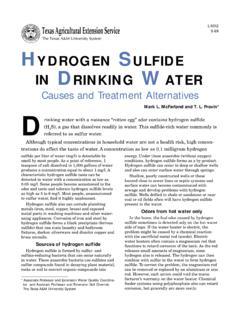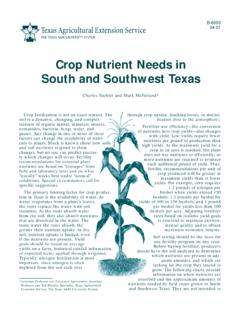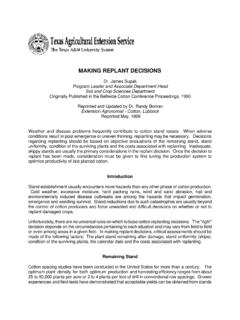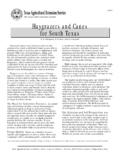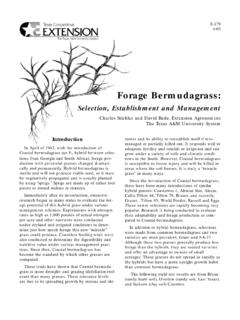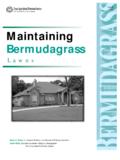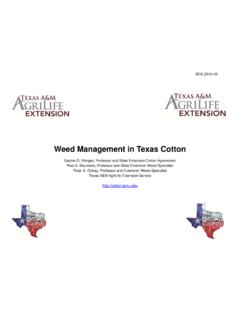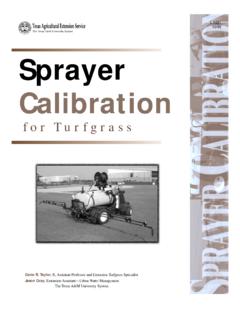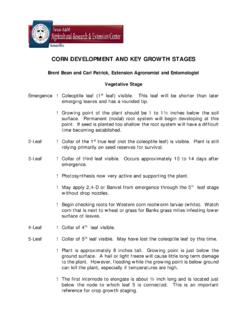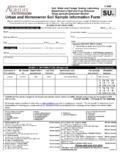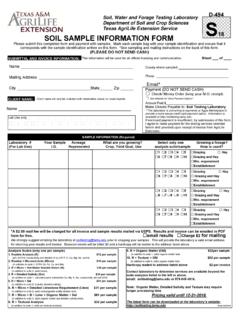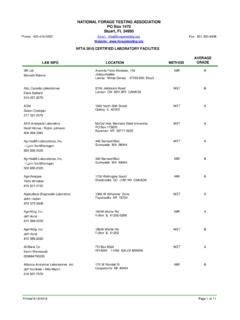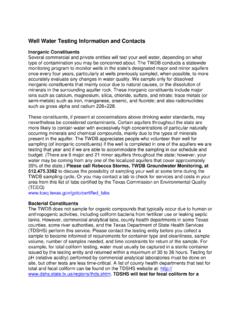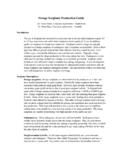Transcription of Defining Forage Quality - Publications Soil and …
1 The Texas A&M University System, Department of Agriculture, and the County Commissioners Courts of Texas Cooperating SCS-2006-09 Defining Forage Quality Subtitle: Nutritive Value of Southern Forages Yoana C. Newman 1 Barry Lambert 2 and James P. Muir3 soil and Crop Sciences Department and Animal Sciences Department Forages with good Quality are the main asset of any livestock operation, and they are also the foundation of most rations in a Forage -based diet. Forages affect individual animal performance. The available nutrients that a Forage carries affects individual animal production ( gain per animal) while the amount of Forage produced affects production per acre. Forages possess a mixture of chemical, physical, and structural characteristics that determine the Quality of that pasture or the accessibility of nutrients to that animal.
2 When forced to think about Forage Quality , different terms come to mind; among others: nutrients, energy, protein, digestibility, fiber, mineral, vitamins and, occasionally but not usually, we may think about animal production. In practical terms Forage Quality has been defined as milk in the bucket a. In programs for Texas producers, it has been defined as pounds on the scale , and some even allow reproduction concerns when stating .. Forage Quality is calves on the ground . For beef, dairy, horse, sheep, or goat production, the ultimate Quality test of Forage is animal performance. This publication discusses the definition of Forage Quality , the main factors affecting Forage Quality , and the components and importance of Forage analyses. 1 Assistant Professor/Extension Forage Specialist, 2 Assistant Professor/Ruminant Nutritionist, and 3 Associate Professor/ Forage Ecologist, Texas A&M University Research and Extension Center, Stephenville, Texas.
3 A See Adesogan et al 2006 in list of references. 2 Forage Quality ? In Defining Forage Quality , a distinction will be made between Forage Quality and Forage nutritive value. Most of the times, these terms are used interchangeably but in this definition of Forage Quality we will follow those that make the distinction between the two terms. Forage nutritive value usually refers to concentration of available energy (total digestible nutrients, TDN) and concentration of crude protein. Forage Quality is a broader term that not only includes nutritive value but also Forage intake. In practice, animal performance of grazing animals reflects Forage Quality . Where forages are the main diet component, Forage Quality of a pasture or crop is determined by animal product (milk, pounds of beef, performance in a horse, etc.).
4 If the animal has the genetic potential, animal production of Forage -based diets depends on the nutritive value of Forage consumed. In other words, how much crude protein concentration, available energy, and minerals are in the Forage tissue, but most importantly, animal performance depends on the intake of the Forage . In instances where grazing management decisions (deliberate or default) result in overgrazed pastures (usually, high stocking rates for an extended period of time), the opportunity to select plant species or plant parts of higher nutritive value decreases and, consequently, Forage intake of animals declines. Figure 1 illustrates how Forage Quality , measured by animal performance (daily gains), decreases with increments in stocking rate. In the example, when pastures are under-stocked, the initial nutritive value of the pastures can be adequate and even in excess of animal requirements; however, under high stocking rates the animal s ability to select forages diminishes over time and the amount of Forage available also decreases.
5 In overgrazed situations, management creates scarce Forage by stocking too many animals; thereby, causing consumption per animal to decrease because the 3forage resource is in short supply. Bottom line: with overstocking fewer nutrients are consumed per animal. Why and how does Forage Quality change? In a pasture not every plant will have the same nutritive value. There are different plant characteristics that directly or indirectly affect Forage Quality . The main factors affecting Quality of a stand are maturity and weathered conditions. Maturity or stage of growth is the principal factor responsible for declining Forage nutritive value. As the plant advances in growth beyond the first couple of weeks (where protein and digestibility are at its highest), stem growth develops as well as deposition of fibrous components at the plant cell level.
6 With advancing maturity, one of the main chemicals deposited internally in the plant cell walls is lignin. Lignin is a component of fiber that is essentially indigestible, accumulates mostly at maturity, and acts as a barrier to fiber degradation by rumen microbes. The microbial population in the rumen is responsible for degrading the Forage fiber and making it available to the animal. If the Forage is too mature, fiber increases and digestibility of the Forage declines as does crude protein (CP) in the Forage tissue. This decline is more pronounced and sudden in warm-season perennial grasses especially in plant tissue that is older than 35-40 days. In Table 1 we can observe how there is a sharp decline in digestibility and crude protein of Coastal bermudagrass after week 5 (35 days) but an increase in fiber (ADF and lignin).
7 As the Forage ages, digestibility and protein drop while fiber increases as indicated by the arrows. 4 Table 1. Nutrient composition of Coastal bermudagrass as affected by maturity (age of forages in weeks). Age of grass Digestibility Crude protein ADF Lignin (weeks) --------------------%------------------- - 4 60 18 29 4 5 59 18 30 4 6 56 16 31 5 7 53 13 33 6
8 Adapted from Mandevu et al. 1999) Another major factor affecting Forage Quality is weather. Poor storage and harvest conditions also lead to losses of sugars due to weathered Forage . Forage that is harvested and not properly dried continues to respire, and with respiration a decrease in soluble sugars occurs. What is in a Forage Analysis? Because the Forage plant characteristics are primarily sensitive to changes over time, timely and regular analyses of Forage are required to know if the Forage meets the daily nutritional requirements of the animals. Commercial laboratory analyses (wet chemistry or near infrared test) include measurement of moisture, protein, and fiber (see Table 2). Intake and energy or total digestible nutrients (TDN) can not be measured directly because this requires testing with animals which may not be practical for all commercial laboratories.
9 5 Table 2. Example of Forage analysis result from bermudagrass hay sample (1st cutting in 2006, fertilized with 80 lb N/acre) from producer in central Texas. ( soil , Water, and Forage Testing Laboratory, Texas A&M University. http: ) Item Moisture Dry matter (DM) ------------------%------------------ As Received Basis Dry Matter Basis Moisture, % 0 Dry Matter, % 100 Crude Protein, % Acid Det. Fiber, % Neutral Det. Fiber, % TDN Est., % Thus, TDN and intake are estimated from equations based on research results where they undergo animal testing.
10 In addition, two indices commonly used to represent Forage Quality will be briefly discussed as they are often misused when it comes to warm-season forages: relative feed value (RFV) and relative Forage Quality (RFQ). Moisture Moisture content is reported usually as wet and dry matter (DM) basis. Wet basis is important because it gives an indication of how much fresh Forage would be required to meet DM requirement of the animals. The second one, DM, is calculated as if the Forage had 6no moisture and this is used to make valid comparisons among different forages. Forage moisture will vary depending on how the Forage is fed (see table 3). Table 3. Moisture and dry matter concentration of different forms of Forage . Item Moisture Dry matter (DM) ------------------%------------------ Hay 8-15 85-92 Silage 65-75 25-45 Fresh Forage Grazing 70-85 15-30 Energy The main sources of energy for ruminants are the products of carbohydrate fermentation in the rumen.
